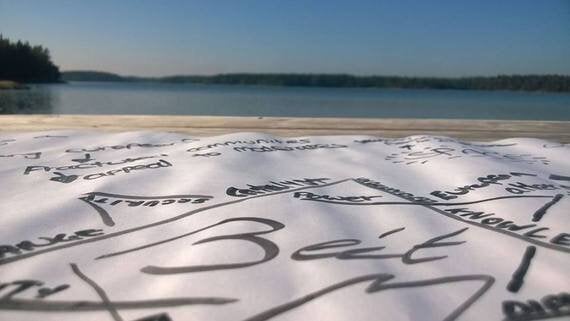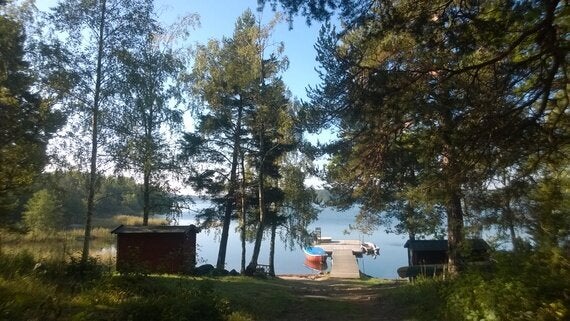
Tucked away in Glämsta is an inviting retreat set amidst a sprawling forest and the Baltic Sea, owned by the Swedish-Jewish community (hyphen required). Its sense of openness made it the perfect location to host the first Beit Makhshava: an initiative which brought a minyan of Jewish thinkers - or thinkers of Judaism - to a space that offers the security and freedom to discuss timely and interconnected issues beyond anti-Semitism and Israel, of which there is a plethora of dedicated and expert organisations. Instead, the vision of Beit Makhshava was born out of a need to reconsider how Jewish communities can contribute to European development rather than questioning the Jewish future in Europe.
Being Jewish in Europe has painful and traumatic memories which have been passed down from generations who lived in, and were often violently erased, from the European continent. The sense of unease triggered by the past may also resurge during cruel acts of hate, such as the notorious murders at the Jewish Museum in Bruxelles and Ozar Hatorah school in Toulouse. But there is also a long history of flourishing amongst the Jewish presence in Europe that has encouraged its endurance and revival, raising many fundamental questions for young Jews today: How has being Jewish and being European been a bilateral process of inspiration and creativity, and how can it continue to be so? How can Jewish knowledge, texts and outlooks be applied to current European issues or visions? How can a European Jewish enterprise be fashioned to export knowledge and innovation to Israel and North America? How can hyphenated and hybridised Jewish identities in Europe serve as a positive model among others now negotiating their presence?
These points are of great relevance to young Jews in the United Kingdom who (rather like our society at large) seem hesitant in capitalising on the exciting opportunities that are brought by greater investment and involvement in Europe, and with European peers and projects. Despite the UK being home to Europe's second largest Jewish community, there remains relatively little activism from Jewish students and young professionals at a European level. In fact, there is no UK student representation on the board of the European Union of Jewish Students (EUJS) and attendance at EUJS events by UK Jewish youths is typically poor, with representation only coming from the current and previous presidents of the UK Union of Jewish Students (UJS).
Perhaps this is down to the emphasis placed on Israel engagement programmes amongst UK Jewish youth movements and networks, as 92% of respondents to the National Jewish Student Survey have claimed to visit Israel and 82% had reportedly participated on an Israel Experience summer programme ('tour') (JPR 2011). It is arguably the case that most UK Jewish youth involvement in Europe centres around subsidised educational tours to Nazi extermination camps, especially the March of the Living tours to Auschwitz-Birkenau. However, these organised visits have received strong criticism for their exclusive focus on exhibiting the extermination of European Jewry against a backdrop of Israeli flags and IDF soldiers, without acknowledging the formidable revival of European Jewish life in the Polish cities of Krakow and Warsaw.
It then becomes easy to divide Jewish life and culture into inaccurate categories of 'diaspora' and 'centre' (Israel), rather than envisioning the diversity of European Jewish communities as being a 'multiplicity of centres which are in relation with each other and with the societies of which they are part' (Beit Makhshava, in press). Yes, there are existential issues of anti-Semitism in Europe, also of a new inter-communal phenomenon, but it is certainly not 'the beginning of the end of Jewish history in Europe' as Natan Sharansky (Chairman of the Jewish Agency for Israel) has claimed in the Jewish Chronicle. Actually it rather feels like we are seeing the beginning of a creative and organic chapter of Jewish continuity in Europe.
The Jewish institutional and spatial landscape continues to change radically, with cultural hubs such as JW3 or Moshe House gradually replacing synagogues as the modern Beit Knesset - centres of 'assembly' for those who are in a state of transition or might feel uncommitted, disengaged, or excluded from mainstream Judaism. For a growing collective, synagogues and Jewish educational institutions are perhaps considered unfamiliar, intimidating and uninviting. They might not accommodate difference or minorities - and they might disregard those seen as threats, particularly individuals who challenge traditional and firmly held ideas of what it means to be Jewish or how to think about Judaism; those who don't believe their gender should be an obstacle to religious leadership or textual learning; those who are 'not-halachically' Jewish; those who are LGBT, or those who feel passionately Jewish but are initiated through a gruelling conversion process that even Ruth might have abandoned. Consequently, an exciting and creative pool of Jewish thinkers is becoming marginal or institutionally disenfranchised and then - dare I say it - assimilated.
But within a Jewish space gently impressed into the expansive Swedish landscape, an intellectual revolution was being imagined by our minyan of activists. To paraphrase Barbara Lerner Spectre, keynote speaker and the Founding Director of Paideia (the European Institute of Jewish Studies in Sweden), Beit Makhshava is striving for a cultured rather than cultural form of Judaism. And it is by no means elitist, as the pioneers of Beit Makhshava "don't like to call it a 'think-tank' because a tank is sealed; they envision their thought as something much more porous, rather as a bayit [home], welcoming and open" (Spectre 2014). The message of the six-day retreat in Sweden is envisioned to become a European-wide initiative to encourage the authentic, sustainable and unbounded use of Jewish textuality amongst emerging generations. Moreover, it can inform the pressing questions young Jews face and nurture the development of Jewish identities in tandem with responsibilities as European nationals.

A defining feature of Beit Makhshava's inaugural retreat was the affectionately termed 'Glämsta Declaration' (In press), at the heart of which was a call from this year's delegates to reclaim the Beit Midrash (Hebrew, House of Study) as a fundamental element of emerging Jewish space. A Beit Midrash is more than a centre of study; it is a methodology, tradition, and outlook. This provocation would see the study and interpretation of Jewish Talmudic texts extend to the hearts of the many, rather than remain in the hands of the few inside exclusive yeshivot or kollelim. Using the methodology of chavruta, small groups would draw inspiration from ancient sources and apply their interpretations to current European affairs. Such a move would provide endless openings for interfaith (and indeed intrafaith) dialogue and enable young Jews to be knowledgeable and interpretive of their religion without necessarily being pushed by an agenda to become more religious.
This call presents Jewish leaders and communities with an historical opportunity to reconnect with Jewish youths and impart the understanding and imagination necessary for them to become future community leaders or visionaries and take a prominent role in an ever-changing and, at times, challenging Europe. Enabling people of different generations, backgrounds, and religions to build a safe environment that enables a state of creative dissent can perhaps be a means of avoiding the corrosive descent many experienced over social media during the conflict in Israel-Palestine this summer. The Beit Midrash model has the potential to show how relationships can thrive over disagreements, presenting an opportunity to engage and share narratives without being in accordance or having to negotiate one's own views.
Whilst Natan Sharansky might be willing to pull the plug on a Jewish role in Europe, it is clear that a passionate generation of Jewish thinkers are striving to secure a future that perpetuates Judaism in the very place that has influenced its diverse cultural, linguistic and religious expression. As Rosh Hashanah just passed, consider opening the door to your mind and bayit, and imagine what this sweet and prosperous 'thought' can yield over the year ahead.
Works Cited:
Beit Makhshavah
http://makhshava.org/
Haber, Gordon. Marching Toward Obscenity: How Remembrance can be Subverted. The Jewish Daily Forward, 13 October 2010.
http://forward.com/articles/132109/marching-toward-obscenity/
Institute for Jewish Policy Research (JPR). 2011. Home and Away: Jewish Journeys Toward Independence.
http://www.jpr.org.uk/documents/Key%20findings%20from%20the%202011%20National%20Jewish%20Student%20Survey.pdf
Sharansky, Natan. Natan Sharansky Exclusive: 'European Idea Will Die Here and Survive in Israel'. The Jewish Chronicle, 24 July 2014.
http://www.thejc.com/news/world-news/120791/natan-sharansky-exclusive-european-idea-will-die-here-and-survive-israel%E2%80%99
Spectre, Barbara Lerner. Why Sharansky is Wrong to Write Off European Jewry. The Jewish Chronicle, 18 August 2014.
http://www.thejc.com/judaism/judaism-features/121527/why-sharansky-wrong-write-european-jewry
Hebrew-English Dictionary
Bayit - home
Beit Knesset - House/Centre of Assembly
Beit Makhshavah - House of Thought
Beit Midrash - House of Study
Chavruta - Peer-guided study
halachically [halachah] - according to Jewish law
Kollel/Kollelim (pl.) - Institutions for advanced study of Talmud and Jewish texts, typically for married men.
Minyan - Quorum of 10 people
Rosh Hashanah - Jewish New Year
Yeshiva/ Yeshivot (pl.) - Institutions for the study of Jewish texts